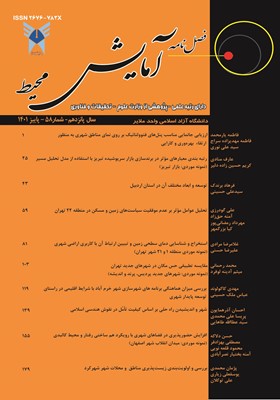رتبهبندی معیارهای مؤثر در برندسازی بازار سرپوشیده تبریز با استفاده از مدل تحلیل مسیر(نمونه موردی: بازار تبریز)
محورهای موضوعی : آمایش محیطعارف منادی 1 , کریم حسین زاده دلیر 2 *
1 - (دانشجوی دکترای گروه هنر و معماری و شهرسازی واحد مرند، دانشگاه آزاد اسلامی، مرند، ایران)
2 - (استاد گروه هنر و معماری و شهرسازی دانشگاه آزاد اسلامی، مرند، ایران
کلید واژه: توسعه گردشگری, بازار, تبریز, برند, بازارهای سنتی,
چکیده مقاله :
هدف از انجام این پژوهش ارزیابی تأثیر شاخصهای گردشگری در توسعه گردشگری و همچنین بررسی برندسازی بازار سرپوشیده تبریز و معیارها و شاخصهای مؤثر در آن میباشد. بر این اساس پس از انجام مطالعات در ارتباط با مبانی و مفاهیم نظری، در مرحله اول پرسشنامههای مورد نظر طراحی گردید و بر مبنای آزمون آلفای گرونباخ از پایایی آنها اطمینان حاصل شد. این پرسشنامهها به منظور مصاحبه با نمونههای آماری سه جامعه آماری مختلف که عبارتند از مشتریان بازار سرپوشیده تبریز، بازاریان و کارشناسان طراحی شدند. به منظور برآورد حجم نمونههای آماری از مدل کوکران استفاده شد. پس از مصاحبه با نمونههای آماری، دادههای اخذ شده در نرمافزار Excel کدگذاری و طبقهبندی شدند. سپس با انتقال این دادهها به نرمافزار Spss، تحلیلهای آماری مربوط به آنها انجام شد. این تحلیلها در دو بخش شناسایی خصوصیات و ویژگیهای عمومی نمونههای آماری و بررسی شاخصهای ارزیابی متغیرهای مستقل صورت پذیرفت. بررسی 58 شاخص در قالب 4 متغیر مستقل تصویر مقصد بازار، هویت بازار، تسهیلات گردشگری بازار و تمایز و منحصر بهفرد بودن بازار و بر اساس طیف لیکرت انجام شد. نتایج حاصل نشان داد که از نظر هر سه گروه میانگین تأثیرگذاری شاخصها و متغیرهای مستقل بر برندسازی بازار سرپوشیده تبریز به عنوان متغیر وابسته زیاد میباشد. بر اساس نتایج حاصل از مدل تحلیل مسیر مشخص شد که بیشترین تأثیرگذاری غیرمستقیم نیز به ترتیب مربوط به متغیرهای تسهیلات گردشگری بازار، تمایز و منحصر بهفرد بودن بازار، تصویرمقصد بازار و هویت بازار میباشد. بررسیهای نهایی نیز نشان داد که بیشترین تأثیرگذاری کل به ترتیب با ضریب تأثیرگذاری 467/0، 262/0، 64/0 و 17/0 مربوط به متغیرهای تمایز و منحصر بهفرد بودن بازار، تسهیلات گردشگری بازار، تصویر مقصد بازار و هویت بازار است.
The purpose of this research is to evaluate the impact of tourism indicators on tourism development, as well as to examine the brand building of Tabriz market and the criteria and indicators that affect it. Accordingly, after conducting studies concerning theoretical and theoretical concepts, the questionnaires were designed in the first stage, and based on Gronbach's alpha test, they were assured of their reliability. These questionnaires were designed to interview statistical samples from three different statistical societies, including Tabriz marketplaces, shopkeepers, and experts. The Cochran model was used to estimate the volume of statistical samples. After interviewing the statistical samples, the data collected in the Excel software were coded and classified. Then, statistical analysis of these data was carried out by transferring these data to the SPSS software. These analyses were carried out in two sections identifying the characteristics and general characteristics of statistical samples and evaluating the indicators of independent variables. 58 indicators were evaluated in the form of four independent variables: market target image, market identity, market tourism facilities, and market differentiation and uniqueness based on the Likert scale. The results showed that for all three groups, the average effect of indices and independent variables on the branded market of Tabriz as a dependent variable is high. Based on the results of the route analysis model, it was determined that indirectly the most influential factors were related to the variables of the market tourism facilities, the distinction and market uniqueness of the market, the image of the market target, and the identity of the market. The final studies also showed that the highest total effect, with coefficients of influence of 0.446, 0.264, 0.264, and 0.17, is related to market differentiation and unique variables, market tourism facilities, market target image, and market identity.
_||_

